Gen AI for Marketing - From Hype to Implementation
Sahar Dolev-Blitental | October 20, 2024
Gen AI has the potential to bring immense value for marketing use cases, from content creation to hyper-personalization to product insights, and many more. But if you’re struggling to scale and operationalize gen AI, you’re not alone. That’s where most enterprises struggle.
To date, many companies are still in the excitement and exploitation phase of gen AI. Few have a number of initial pilots deployed and even fewer have simultaneous pilots and are building differentiating use cases. Only a handful have select use cases running at scale, and no company, per McKinsey’s knowledge, is using gen AI as the new normal in their day-to-day use cases.
In this blog post, we provide a staged approach for rolling out gen AI, together with use cases, a demo and examples that you can implement and follow. For more details, watch the webinar this blog post is based on. The webinar hosts Eli Stein, Partner and Modern Marketing Capabilities Leader from McKinsey, Ze’ev Rispler, ML Engineer, from Iguazio (acquired by McKinsey), and myself. Watch the entire webinar here.
Marketing and Technology: A Historical Perspective
Marketing is frequently being disrupted by technology. This has occurred with computing in the 1970s, the Internet in the 1990s and mobile in the 2000s. In 2022, “AI everywhere” has enabled zero marginal cost of content generation. In the upcoming years, we can expect to see AGI (Artificial General Intelligence), which will provide intelligence beyond human capabilities, at zero marginal cost.
And similar to how some marketers were left behind in previous tech revolutions, some will be left behind for this one as well.
Gen AI Value for Marketers
According to McKinsey research, there is:
- $460 billion value potential in marketing alone, when using gen AI for marketing applications
- 5%-15% improvements in productivity, as a percentage of total marketing spend
- More than 90% of leaders have started experimenting with gen AI for marketing
Gen AI in Marketing: Where Companies Start
The first step most companies take when looking at gen AI opportunities for marketing use cases is in campaign development. Gen AI offers numerous automation opportunities in this field:
- Campaign strategy
- Standardized briefings
- Concept and visual asset creation
- Copy development
- Layout integrations
- Reviews and approvals
- Implementation, including localization and personalization
- Testing across browsers and devices
- Launching
How Gen AI will Transform Marketing
But gen AI has much more to offer marketing. Gen AI has the potential to go beyond content creation and campaign development. This includes:
- Product discovery - Improving conversion through search and chatbots by offering interactive discovery and response experience for customers. E.g, a travel agency offering a chatbot that builds travel itineraries or a grocery store offering meal planning.
- Hyper-personalization - Automatic creation and deployment of micro-segmented or personalized content and experiences across thousands of user segments. These are optimized through reinforcement learning and feedback loops.
- Creative efficiency and media optimization - Generating more customer-facing content and faster. This includes creating thousands of assets and testing among sub-groups.
- Insights syntheses and activation - A searchable synthesis engine that aggregates real-time insights and can inform marketing strategy and execution.
- Automation of the “business of marketing” - Automating non-creative marketing tasks. E.g, first drafts for research reports, agency briefs, media plans, quarterly reviews, etc. This can bring a 50x increase in the speed of creation.
Example: Hyper-Personalization at a Consumer Bank
A bank used gen AI to create hyper-personalized marketing messaging. This replaces manual campaign personalization based on simple customer segmentation, which is what most banks do. This results in money being left on the table.
The gen AI application included Next-Best-Action ML models, an interactive application to manage the process and for feedback loops, and guardrails and governance protocols. They also proposed a framework to validate the impact of hyper-personalized marketing action.
Here are two examples of very different hyper-personalized content with the same offering, based on individual customer attributes:
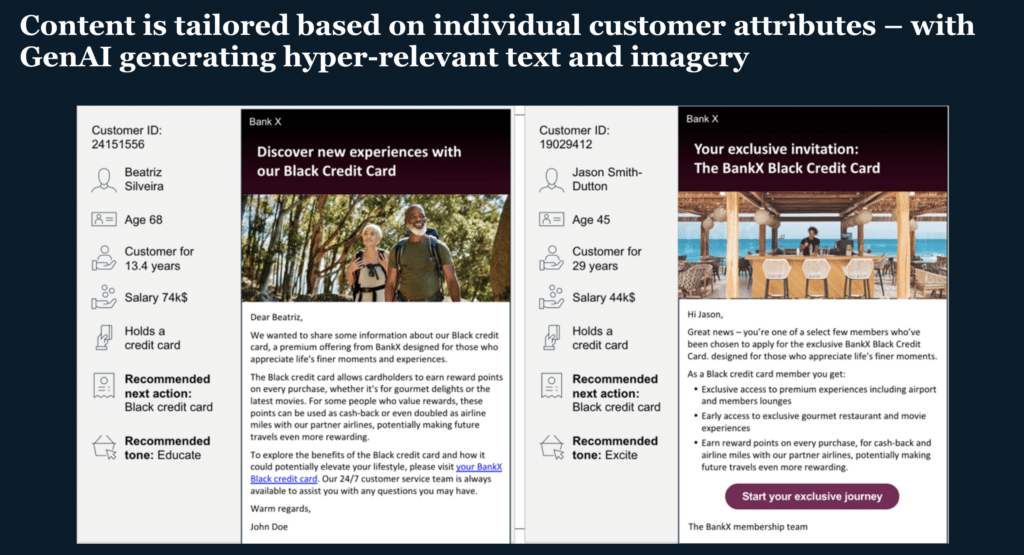
How does this work under the hood?
The bank already had customer data. E,g, ages, salaries, how long they’ve been a customer, products they use, etc.
Traditional AI can provide a prediction of how likely the customer was to purchase an additional product or an upsell. E.g, 85% chance of propensity for a new credit card within 3 months, and a recommendation to engage on the SMS channel in the afternoon.
Gen AI was used to generate the messages themselves, based on the right channel and cadence. For example, a text message going out on Tuesday, an email on Friday and another message the following Friday.
The results:
- 20% increase in conversion rates
- 80% decrease in production costs
Watch the webinar to see another gen AI marketing example. It shows a leading industrial distributor that built an AI-powered lead gen model to identify and pursue new customer and product recommendations. They also used gen AI to create personalized emails at scale to accelerate outreach. This resulted in $1 bulling opportunities identified across 500,000 companies and 25X improvement in email outreach rate.
A Staged Approach for Rolling Out Gen AI
Implementing gen AI for marketing can be daunting. Therefore, a staged approach can assist with implementation. For example, start with back office tasks rather than the highest risk areas.
Here’s an example of a staged approach for a call center analysis application that transcribes and analyzes customer calls from a large call center. This is based on an example of an Iguazio customer.
Stage 1: Call Analysis and Optimization
This stage includes transcribing and translating calls to analyze which topics are being discussed, sentiment, the percentage of successfully resolved calls, etc. These insights can be fed to downstream applications.
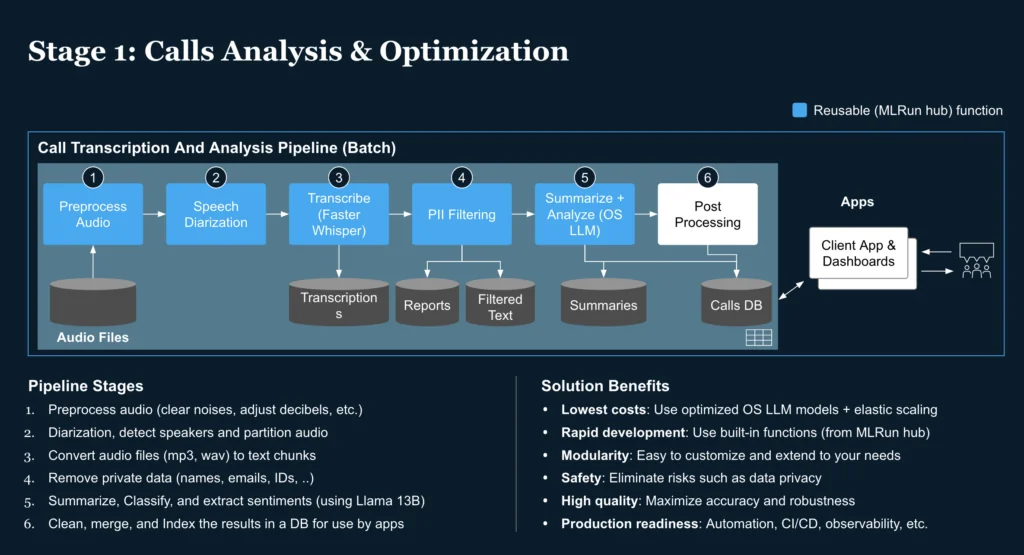
Stage 2: Agent Co-pilot
The agent co-pilot is an application or an assistant that helps the human agent throughout conversations. In the call center example, the real-time co-pilot agent sits on top of the agent's desktop and can surface insights.
For example, it can surface information from the company's guidelines, documentation, company processes, etc. These can help the agent have better conversations. They can also listen in for sentiment, flag keywords that the customer is saying, etc.
Another use case is helping train new human agents. The agent co-pilot can slash times for handling requests and improve customer satisfaction.

Stage 3: Smart Agent/VSME
The highest level of implementation is a virtual agent that connects directly and speaks directly with customers. This can be executed through video, audio, or chatbot. The risk level is higher because they're conversing directly with the customer in real-time. This warrants risk mitigation at the technological level, to ensure the smart agent is aligned with company policy and doesn't go off topic.
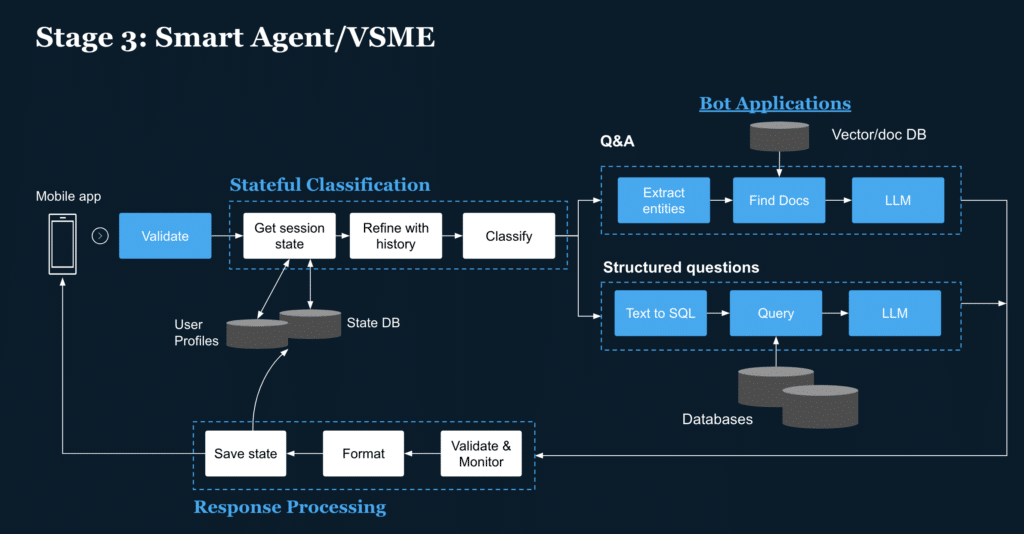
Demo: IguaJewels
Now let’s see such a gen AI chatbot in action. IguaJewels, is an online jewelry store that would like to create a gen AI chatbot on their website.
Chatbot Requirements
The virtual assistant should:
- Recommend jewelry based on the customer's purchase history.
- Recommend jewelry based on client's event, occasion or outfit.
- Answer questions about the jewelry offered by the store.
- Answer questions regarding store policies.
Architecture Logic
The virtual assistant was operationalized and de-risked with the Iguazio gen AI factory. Capabilities include session loading, query refinement, history saving, guardrails like subject classification and a toxicity filter, connection to monitoring, the ability to iterate and retrain the model, external database connections, and more.
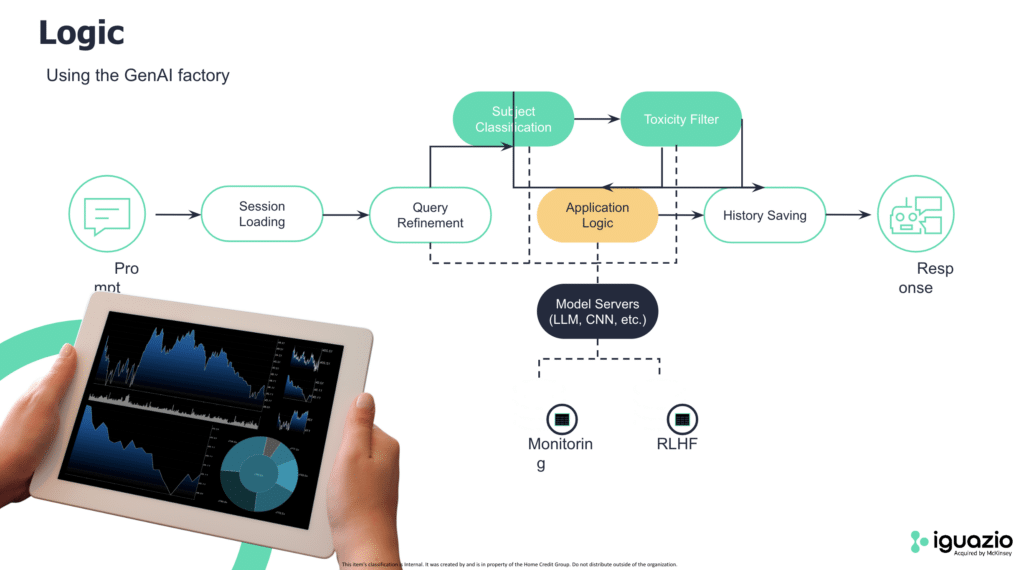
The Role of the LLM Agents
The core idea of agents is to use a language model to choose a sequence of actions to take. In chains, a sequence of actions is hardcoded (in code). In agents, a language model is used as a reasoning engine to determine which actions to take and in which order. Agents combine the power of LLMs with specific functionalities or 'tools' that they can decide to use.
Key features include:
- Task Planning - Can break down complex tasks into manageable steps.
- Tool Use - Can leverage external tools APIs to accomplish tasks.
- Adaptability - Can handle a wide range of tasks across different domains.
- Continuous Learning - Can be fine-tuned or updated with new information.
Agent Application Logic
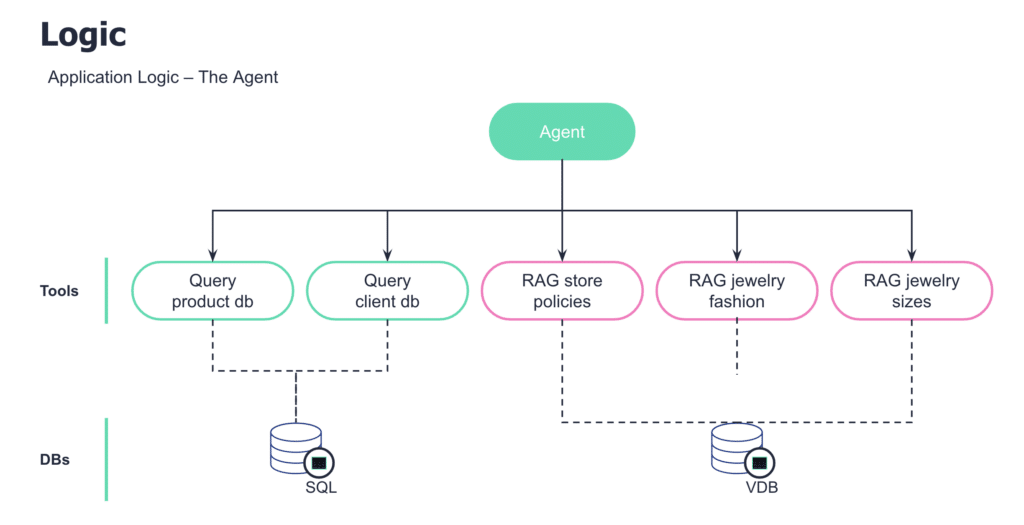
This agent could use 5 tools: query product DB, query client DB, RAG store policies, RAG jewelry fashion and RAG jewelry sizes. They also had access to a database with client data and a database with product data. These enable the LLM to ask queries and generate responses in a contextual manner.
Watch the demo itself to see how the agent helps a confused husband shopping for a gift. It asks for essential details like the occasion and preferences but can also deduce recommendations based on minimal input. For example, knowing the customer doesn’t want rings, bracelets, or is unsure about earrings. The agent adjusts the conversation based on the customer’s responses. For example, when choosing the necklace materials. Finally, the LLM answers questions about payment methods.
Responsible AI from Day One
When introducing gen AI into the organization, it’s important to address the following risk categories:
- Impaired fairness - Algorithmic bias; misrepresentation of generated content as human-created
- IP infringement - Infringement on copyrighted or otherwise legally protected materials
- Privacy concerns - Unauthorized use/disclosure of personal or sensitive information
- Malicious use - Al-generated promulgation of malicious content
- Performance & explainability risk - Inability to explain model outputs appropriately and model inaccuracies
- Security threats - Vulnerabilities in generative Al systems that may be breached or exploited
- ESG impact - Employment implications, bias and fairness challenges, governance and ethical impact, leading to reputational risk
- Third-party risk - Risks associated with the use of third-party Al tools
Implementing guardrails like LLM-as-a-Judge can help mitigate these risks. For example, it can reduce AI hallucinations, remove PII (Personal Identifiable Information), etc. Additional guardrails include human-in-the-loop, a feedback loop, and more.
6 Truths to be Able to Scale Gen AI
Based on our experience working with global enterprises, here are six methods that can help scale gen AI and reap the benefits:
1 Cut the noise, keep the signal - Be honest about what pilots have worked. Cut down on experiments. Direct your efforts toward solving important business problems that bring ROI while thinking at scale.
2. It's not just about the pieces - it's how they fit together - Scale relies on effective orchestration of the many interactions through end-to-end automation. This starts from data wrangling and constructing data pipelines all the way to monitoring models and conducting risk reviews using "policy as code". Narrow down to those capabilities that best serve the business, and take advantage of available cloud services (while preserving your flexibility).
3, Manage costs before they manage you - Models account for only about 15% of the overall cost of gen Al applications. Change management (the need to build a new skill set with non-technical users - prompt engineering, hallucination training) and ongoing run costs (2-3X build cost, GPU provisioning) are a big share of the total program cost. CIOs need to shift the business's energies to building transversal solutions that can serve many use cases.
4 Assemble minds, not just models - Getting to scale requires a team with a broad cross-section of skills to not only build models but also make sure they generate the proper value. Gen Al initiatives need to be treated as a broader business priority, requiring integration of across teams. IT, business and risk leads need to work hand-in-hand
5 Get the right data, not the perfect data - Large data programs are the surest path to slow death. Instead, focus on the data domains that have the most impact and drive value for the high priority use cases. Don't solve everything.
6 Embrace challenges to enable growth - Generative Al high performers report experiencing a range of challenges in capturing value from the technology. (i.e., inaccuracy and intellectual property infringement). Gen Al risk awareness and mitigation, e.g through guardrails and governance techniques, are required skills for technical talent.


